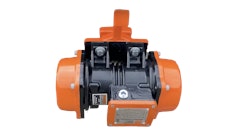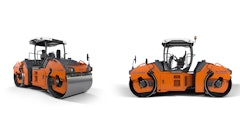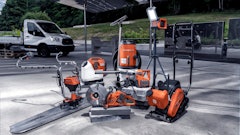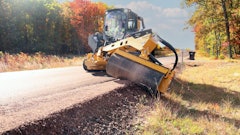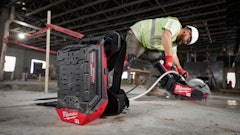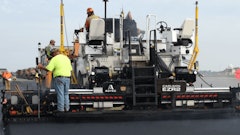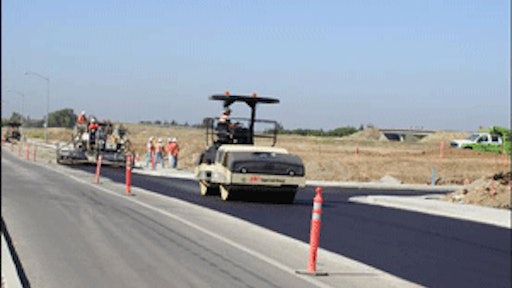
Many paving projects employ a common practice that contractors should avoid. That practice is rolling too fast with the breakdown compactor, especially when using a vibratory compactor. Many operators attribute excessive speed to the perceived need to keep up with the paver. However, when this practice is followed, the contractor typically finds out that one or more density tests fail to meet minimum requirements. Predictably, the breakdown compactor operator is blamed.
It is true that breakdown compaction must be accomplished while the mix has low enough viscosity to permit aggregate particle rearrangement that eliminates most of the voids in the pavement structure. Certainly, the compactor train needs to keep up with the average forward speed of the paver. There are also instances where the paver moves too fast for the breakdown compactor to keep up. Depending upon the delivery of mix, and paving width and depth, a contemporary paver, with a vibratory screed and automatic controls for grade and slope, is capable of laydown at rates up to 100 feet (30 meters) per minute or faster. It is impossible for a single breakdown compactor to keep up with the paver at these rates of production. Even compactors with the highest vibration frequency levels are pressed to compact at a sufficient speed to keep up with a paver moving at this speed.
Ingersoll Rand DD-138HFA compactors are often used as breakdown compactors. If the drums on the compactor are set to the first amplitude setting for compaction of a thin overlay, the rolling speed - using the automatic speed control system that provides 12 impacts per foot drum impact spacing - is 3.8 miles per hour. To convert miles per hour into feet per minute, multiply by 88. This compactor will move at 334 feet (101 meters) per minute when operated with the automatic speed "cruise control" system.
Another way of establishing appropriate compaction speed is through the control of drum impact spacing. If the breakdown compactor is the same DD-138HFA in the previous example, a high frequency model with 4,000 vibrations per minute, and based on a large drum diameter that requires a spacing of 10 impacts per foot vibration for smoothness, rolling speed when vibrating is 400 feet (122 meters) per minute.
The average forward speed of any compactor is determined by the rolling speed divided by the number of passes. The DD-138HFA in a five-pass rolling pattern has an average speed of 66.88 feet (20.39 meters) per minute. For the second example, average speed of the DD-138HFA with a five-pass rolling pattern is 80 feet (24 meters) per minute. Clearly for neither example will this compactor be able to keep pace with a paver moving 100 feet (30 meters) per minute.
Managing a paving project is a balancing act. It is necessary to equalize material production and delivery with laydown and compaction. Whenever one or more of these activities becomes unbalanced, problems occur. If sufficient mix can be produced and delivered to the paver to permit it to operate continuously at a speed of 100 feet (30 meters) per minute, what is a paving crew supposed to do to earn the available incentives for density and smoothness? The solution is to have tandem breakdown compactors or two breakdown compactors working in echelon. These two compactors should have similar size, weight and vibration characteristics so that performance is equal and uniform across the width and length of the pavement.
Adding a second breakdown compactor usually permits the entire paving train to move faster and achieve higher production. This productivity gain can more than offset the added cost of owning and operating the second breakdown compactor. Having added breakdown compaction capacity also reduces the need for intermediate compaction and expedites the finish rolling process.
An added benefit of two breakdown compactors working together behind a paver is consistency, and uniformity of density and smoothness readings. Since the pair of compactors do not need to operate at excessive rolling speeds in order to keep up with the paver, the smoothness of the pavement behind the compactors is superior.
When a surface appears like that in the photograph to the right, the contractor fails to earn the incentive for smoothness and this project is negatively received by the public using the corrugated surface. This is avoided by paying attention to rolling speed, especially with vibratory compactors.
Highway-class vibratory compactors need to make 10 to 14 impacts per foot (33 to 46 impacts per meter) with each drum. Larger diameter drums can produce acceptable results with wider impact spacing; smaller diameter drums need closer impact spacing to achieve smoothness.
Ingersoll Rand recommends the following:
- Drums under 40 inches (1015 millimeters) in diameter: 14 impacts per foot (46 impacts per meter)
- Drums up to 50 inches (1270 millimeters) in diameter: 12 impacts per foot (39 impacts per meter)
- Drums up to 59 inches (1499 millimeters) in diameter: 10 impacts per foot (33 impacts per meter)
The largest compactors, with drums larger than those listed above, may produce acceptable surface smoothness results with drum impact spacing as low as 8 impacts per foot (26 impacts per meter). For assurance of performance, it is always recommended to set up a test strip to prove the rolling pattern and rolling speed. Appropriate density and smoothness tests will confirm the rolling pattern and speed selected will give the desired results on the test strip.










